Lin S.D. Water and Wastewater Calculations Manual
Подождите немного. Документ загружается.

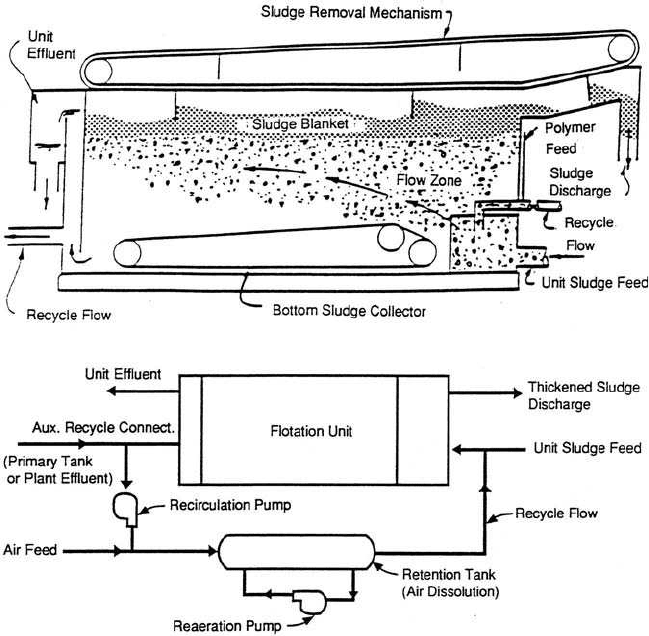
(d) Compute total solids out
Solids out ⫽ (Step 2b) ⫹ (Step 2c) ⫽ (12,240 ⫹ 290) kg/d
⫽ 12,530 kg/d
(e) Compare Steps 2a and 2d
Solids in 19,200 kg/d ⬎ solids out, 12,530 kg/d
Answer: The sludge blanket will increase in depth.
Note: the withdrawal rate also can be expressed as per minute
Dissolved air flotation thickening. Flotation thickeners include dissolved
air flotation (DAF), vacuum flotation, and depressed-air flotation. Only
DAF is used for wastewater sludge thickening in the US. It offers sig-
nificant advantages in thickening light sludges such as activated sludge.
The DAF thickener (Fig. 6.56) separates solids from the liquid phase in
Wastewater Engineering 805
Figure 6.56 Dissolved air flotation thickener (source: US EPA, 1991).
an upward direction by attaching fine air bubbles (60 to 100 mm) to
particles of suspended solids which then float. The influent stream at
the tank bottom is saturated with air, pressurized (280 to 550 kPa),
then released to the inlet distributor. The retention tank is maintained
at a pressure of 3.2 to 4.9 kg/cm
2
(45 to 70 lb/in
2
) (US EPA, 1987b).
The ratio of the quantity of air supplied and dissolved into the recy-
cle or waste stream to that of solids (the air-to-solids, A/S ratio) is prob-
ably the most important factor affecting the performance of the flotation
thickener. Normal loading rates for waste activated sludge range from
10 to 20 kg solids/(m
2
.
d) (2 to 4 lb/(ft
2
.
d)). DAF thickening produces
about 4% solids with a solids recovery of 85% (Hammer, 1986). The
sludge volume index, SVI, is also an important factor for DAF operation.
Example 1: Determine hydraulic and solids loading rates for a DAF thick-
ener. The thickener, of 9 m (30 ft) diameter, treats 303 L/min (80 gal/min) of
waste activated sludge with a TSS concentration of 7800 mg/L.
solution:
Step 1. Calculate liquid surface area
Area ⫽ p (9 m/2)
2
⫽ 63.6 m
2
Hydraulic loading ⫽ (303 L/min)/63.6 m
2
⫽ 4.76 L/(min
.
m
2
)
Step 2. Calculate solids loading rate
TSS in WAS ⫽ 7800 mg/L ⫽ 0.78%
Solids loaded ⫽ 303 L/min ⫻ 60 min/h ⫻ 1 kg/L ⫻ (0.78%/100%)
⫽ 141.8 kg/h
Solids loading rate ⫽ (141.8 kg/h)/(63.6 m
2
)
⫽ 2.23 kg/(m
2
.
h)
⫽ 53.3 kg/(m
2
.
d)
⫽ 10.9 lb/(ft
2
.
h)
Example 2: A DAF thickener treats 303 L/min (80 ft/min) of waste acti-
vated sludge at 8600 mg/L. Air is added at a rate of 170 L/min (6.0 ft
3
/min).
Determine the air-to-solids ratio. Use 1.2 g of air per liter of air (0.075 lb/ft
3
)
under the plant conditions.
solution:
Step 1. Compute mass of air added
Air ⫽170 L/min ⫻ 1.2 g/L
⫽ 204 g/min
806 Chapter 6

Step 2. Compute mass of solids treated
Solids ⫽ 8.6 g/L ⫻ 303 L/min
⫽ 2606 g/min
Step 3. Compute A/S ratio
A/S ⫽ (204 g/min)/(2606 g/min)
⫽ 0.078 g air/g solids
or ⫽ 0.078 lb air/lb solids
Example 3: Determine the concentration factor and the solids removal effi-
ciency of a DAF thickener with conditions the same as in Example 2. The
thickened sludge or float has 3.7% solids and the effluent TSS concentration
is 166 mg/L.
solution:
Step 1. Compute the concentration factor CF
From Example 2,
The influent sludge solids content ⫽ 8600 mg/L
⫽ 0.86%
⫽ 4.3
Step 2. Compute the solids removal efficiency
Centrifuge thickening. A centrifuge acts both to thicken and to dewater
sludge. The centrifuge process separates liquid and solids by the influence
of centrifugal force which is typically 50 to 300 times that of gravity (WEF
and ASCE, 1996b). Centrifuges may be used for thickening waste acti-
vated sludge or as dewatering devices for digested or conditioned sludges.
Three basic types (solid bowl, imperforate basket, and disc-nozzle) are
commonly installed to thicken or dewater wastewater sludge.
The solid bowl scroll centrifuge (Fig. 6.57) is the most widely used type.
It rotates along a horizontal axis and operates in a continuous-feed
manner. It consists of a rotating bowl having a cylindrical-conical shape
5 98.1%
5
s8600 2 166d mg/L 3 100%
8600 mg/L
Efficiency 5
influent TSS 2 effluent TSS
inf luent TSS
CF 5
float solids content
influent solids content
5
3.7%
0.86%
Wastewater Engineering 807
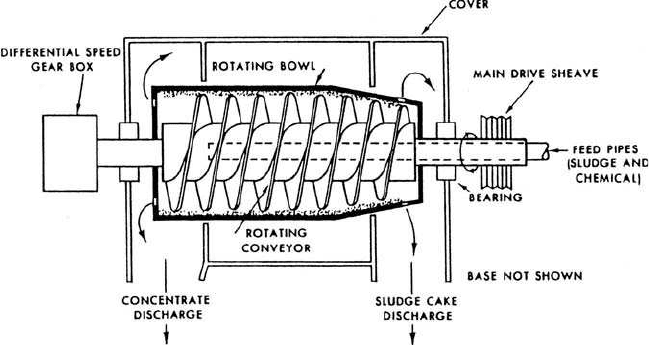
and a screw conveyer. Sludge is introduced into the rotating bowl
through a stationary feed pipe continuously and the solids concentrate
on the periphery. The gravitational force causes the solids to settle out
on the inner surface of the rotating bowl. A helical scroll, spinning at a
slightly different speed, moves the settled solids toward the tapered
end (outlet ports) and then discharges them. The light liquid pools above
the sludge layer flows toward the concentrate outlet ports. The unit
has a low cost/capacity ratio.
The basket centrifuge, also called the imperforate bowl (Fig. 6.58),
is a knife-discharge type and operates on a batch basis. Liquid sludge
is transported by a pipe through the top and is fed to the bottom of a
vertically mounted spinning bowl. Solids accumulate against the wall
of the bowl by centrifugal force and the concentrate is decanted. The
duration of the feed time is controlled by a preset timer or a concentrate
monitor (usually 60% to 85% of maximum depth). When the feed is
stopped, the bowl begins to decelerate. As a certain point a nozzle skim-
mer (plow or knife) enters the bowl to remove the retained solids. The
solids fall through the bottom of the bowl into a hopper. The plow
retracts and the bowl accelerates, starting a new cycle. The units needs
a skilled operator.
The disc-nozzle centrifuge (Fig. 6.59) rotates along a vertical axis and
operates in a continuous manner. The liquid sludge is fed normally
through the top of the unit (bottom feed is also possible) and flows
through a feedwell in the center of the rotor and to a set of some 50 con-
ical discs. An impeller within the rotor accelerates and distributes the
feed slurry, filling the rotor interior. The centrifugal force is applied to
808 Chapter 6
Figure 6.57 Solid bowl scroll centrifuge (source: US EPA, 1991).
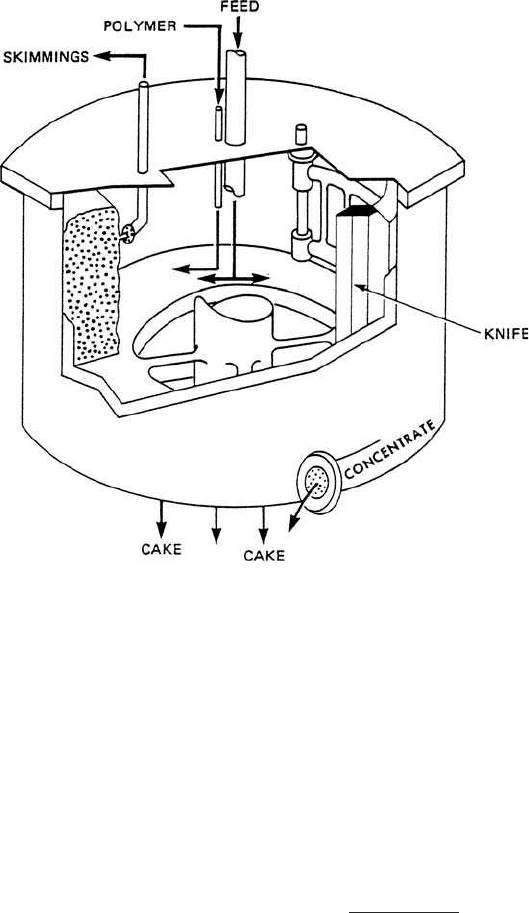
the relatively thin film of liquid and solid between the discs. The force
throws the denser solid materials to the wall of the rotor bowl, where it
is subjected to additional centrifugal force and concentrated before it is
discharged through nozzles located on the periphery. The clarified liquid
passes on through the disc stack into the weir at the top of the bowl, and
is then discharged.
The performance of a centrifuge is usually determined by the per-
centage of capture. It can be calculated as follows:
(6.213)
where C
r
⫽ concentration of solids in rejected wastewater (concentrate),
mg/L, %
C
c
⫽ concentration of solids in sludge cake, mg/L, %
C
s
⫽ concentration of solids in sludge feed, mg/L, %
Percent capture 5 c1 2
C
r
sC
c
2 C
s
d
C
s
sC
c
2 C
r
d
d 3 100
Wastewater Engineering 809
Figure 6.58 Schematic of imperforate basket centrifuge (source:
US EPA, 1991.)
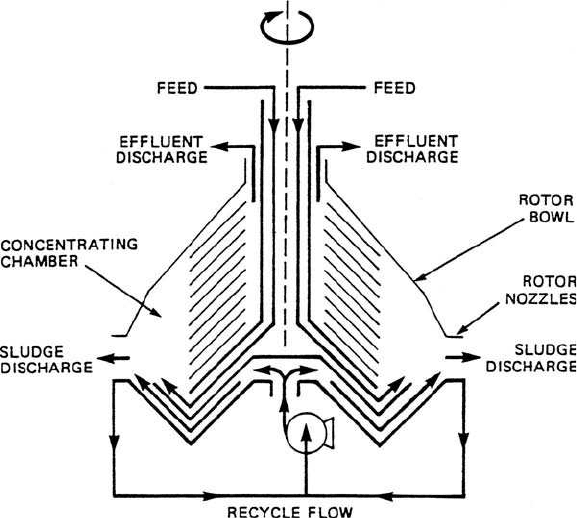
Example: A basket centrifuge is applied with 378 L/min (100 gal/min) of
waste activated sludge at a solids content of 0.77%. The basket run time for
80% depth is 18 min with a skimming operating time of 2 min. The average
solids content in the thickened sludge is 7.2%. The solids concentration in the
effluent is 950 mg/L. Determine hourly hydraulic loading and solids loading,
dry solids produced per cycle and per day, and the efficiency of solids capture.
solution:
Step 1. Calculate hydraulic loading (HL) rate
HL ⫽ 378 L/min ⫻ 60 min/h
⫽ 22,680 L/h (⫽22.7 m
3
/h)
⫽ 5990 gal/h
Step 2. Calculate solids loading SL
SL ⫽ 378 L/min ⫻ 60 min/h ⫻ (0.77%/100%) ⫻ 1 kg/L
⫽ 175 kg/h
⫽ 385 lb/h
810 Chapter 6
Figure 6.59 Schematic of a disc-nozzle centrifuge (source: US EPA, 1991).

Step 3. Calculate the solids production per cycle and per day
Step 4. Calculate the efficiency of solids capture
Given: C
r
⫽ 950 mg/L ⫽ 0.095%
C
c
⫽ 7.2%
C
s
⫽ 0.77%
Using Eq. (6.213)
Gravity belt thickening. The gravity belt thickener is a relatively new
sludge thickening technique, stemming from the application of belt
presses for sludge dewatering. It is effective for raw sludge and
digested sludge with less than 2% solids content. A gravity belt moves
over rollers driven by a variable-speed drive unit. The sludge is con-
ditioned with polymer and applied into a feed/distribution box at one
end. The sludge is distributed evenly across the width of the moving
belt as the liquid drains through, and the solids are carried toward
the discharge end of the thickener and removed. The belt travels
through a wash cycle. Additional material on gravity belt thickeners
and rotary drum thickeners may be found in WEF and ASCE (1991b,
1996b).
Example 1: An operator adds 2 lb (0.91 kg) of a dry polymer to 50 gal (189 L)
of water. What is the polymer strength?
5 88.8%
5 c1 2
0.095s6.2 2 0.77d
0.77s6.2 2 0.095d
d 3 100%
Efficiency 5 c1 2
C
r
sC
c
2 C
s
d
C
s
sC
c
2 C
r
d
d 3 100%
5 8330 lb/d
5 3780 kg/d
Solids produced per day 5
52.5 kg/cycle 3 1440 min/d
20 min/cycle
Total time for each cycle 5 18 min 1 2 min 5 20 min/cycle
5 52.5 kg/cycle
Solids produced per cycle 5
175 kg/h 3 18 min/cycle
60 min/h
Wastewater Engineering 811

solution:
Step 1. Calculate the mass of water plus polymer, W
W ⫽ 50 gal ⫻ 8.34 lb/gal ⫹ 2 lb
⫽ 419 lb
Step 2. Calculate the strength of polymer solution
Example 2: Determine the amount of dry polymer needed to prepare a 0.12%
solution in a 1000-gal (3.78 m
3
) tank. If 8 gal/min of this 0.12% polymer solu-
tion is added to a waste activated sludge flow of 88 gal/min (333 L/min) with 8600
mg/L solids concentration, compute the dosage of polymer per ton of sludge.
solution:
Step 1. Compute dry polymer required for 1000-gal solution
Polymer ⫽ 1000 gal ⫻ 8.34 lb/gal ⫻ (0.12%/100%)
⫽ 10.0 lb
Step 2. Compute the dosage in lb/ton of sludge
Sludge stabilization. After sludge has thickened, it requires stabiliza-
tion to convert the organic solids to a more refractory or inert form.
Thus the sludge can be handled or used as a soil conditioner without
causing a nuisance or health hazard. The purposes of sludge stabiliza-
tion are to reduce pathogens, eliminate odor-causing materials, and to
inhibit, reduce, and eliminate the potential for putrefaction.
Treatment processes commonly used for stabilization of wastewater
sludges include anaerobic digestion, aerobic digestion, chemical (lime,
disinfectants) stabilization, and composting.
Anaerobic digestion. Anaerobic sludge digestion is the biochemical degra-
dation (oxidation) of complex organic substances in the absence of free
oxygen. The process is one of the oldest and most widely used methods.
5 25.4 lb polymer/ton dry sluge solid
5
8 gal/min 3 8.34 lb/gal 3 0.12% 3 2000 lb/ton
88 gal/min 3 8.34 lb/gal 3 0.86%
Dosage 5
lb polymer added
lb dry solid
3
2000 lb
ton
Solids at 8600 mg/L 5 0.86%
Polymer strength 5
mass of polymer
total mass
5
2 lb
419 lb
3 100% 5 0.48%
812 Chapter 6
During anaerobic digestion, energy is released, and much of the volatile
organic matter is converted to methane, carbon dioxide, and water. Thus
little carbon and energy are available to sustain further biological activ-
ity, and the remaining residuals are rendered stable.
Anaerobic digestion involves three basic successive phases of fer-
mentation: hydrolysis, acid formation, and methane formation (WEF
and ASCE, 1996b; US EPA, 1991). In the first phase of digestion, extra-
cellular enzymes (enzymes operating outside the cells) break down com-
plex organic substances (proteins, cellulose, lignins, lipids) into soluble
organic fatty acids, alcohols, carbon dioxide, and ammonia.
In the second phase, acid-forming bacteria, including facultative bac-
teria, convert the products of the first stage into short-chain organic
acids such as acetic acid, propionic acid, other low molecular weight
organic acids, carbon dioxide, and hydrogen. These volatile organic acids
tend to reduce the pH, although alkalinity buffering materials are also
produced. Organic matter is converted into a form suitable for break-
down by the second group of bacteria.
The third phase, strictly anaerobic, involves two groups of methane-
forming bacteria (methanogens). One group converts carbon and hydro-
gen to methane. The other group converts acetate to methane, carbon
dioxide, and other trace gases. Both groups of bacteria are anaerobic.
Closed digesters are used for anaerobic digestion. It should be noted that
many authors consider only two phases (excluding phase 1 above).
The most important factors affecting the performance of anaerobic
digesters are solids residence time, hydraulic residence time, tempera-
ture, pH, and toxic materials. Methanogens are very sensitive to envi-
ronmental conditions. Anaerobic digesters are usually heated to
maintain a temperature of 34 to 36⬚C (94 to 97⬚F). The methane bacte-
ria are active in the mesophilic range (27 to 43⬚C, 80 to 110⬚F). They have
a slower growth rate than the acid formers and are very specific in food
supply requirements. The anaerobic digester (two-stage) usually pro-
vides 10 to 20 days’ detention of sludge (WEF and ASCE, 1996b).
Optimum methane production typically occurs when the pH is main-
tained between 6.8 and 6.2. If the temperature falls below the operat-
ing range and/or the digestion times falls below 15 days, the digester
may become upset and require close monitoring and attention.
If concentrations of certain materials such as ammonia, sulfide, light
metal cations, and heavy metals increase significantly in anaerobic
digesters, they can inhibit or upset the process of performance.
The key parameter for digester sizing is solids residence time. For
digester systems without recycle, there is no difference between SRT and
HRT. Volatile solids loading rate is also used frequently as a basis for
design. Typically, design SRT values are from 30 to 60 days for low-rate
digesters and 10 to 20 days for high-rate digesters (WEF and ASCE, 1991b).
Wastewater Engineering 813
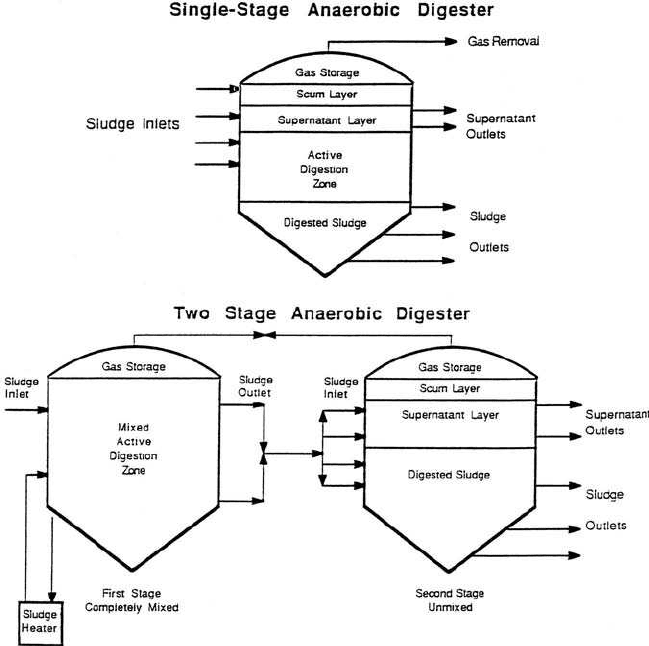
Volatile solids loading criteria are generally based on sustained load-
ing conditions (typically peak month or peak week solids production),
with provisions for avoiding excessive loading during shorter time peri-
ods. A typical design sustained peak volatile solids loading rate is 1.9 to
2.5 kg VS/(m
3
⭈ d) (0.12 to 0.16 lb VS/(ft
3
⭈ d)). A maximum limit of 3.2 kg
VS/(m
3
⭈ d) (0.20 lb VS/(ft
3
⭈ d)) is often used (WEF and ASCE, 1991b).
The configuration of an anaerobic digester is typically a single-stage
or two-stage process (Fig. 6.60). For the low rate, single-stage digester,
three separate layers (scum, supernatant, and sludge layers) form as
decomposition occurs. The stabilized (digested) sludge settles at the
bottom of the digester. The supernatant is usually returned to the plant
influent. In a single-stage high rate process, the digester is heated and
814 Chapter 6
Figure 6.60 Configuration of (a) single-stage and (b) two-stage anaerobic digesters
(source: US EPA, 1991).
